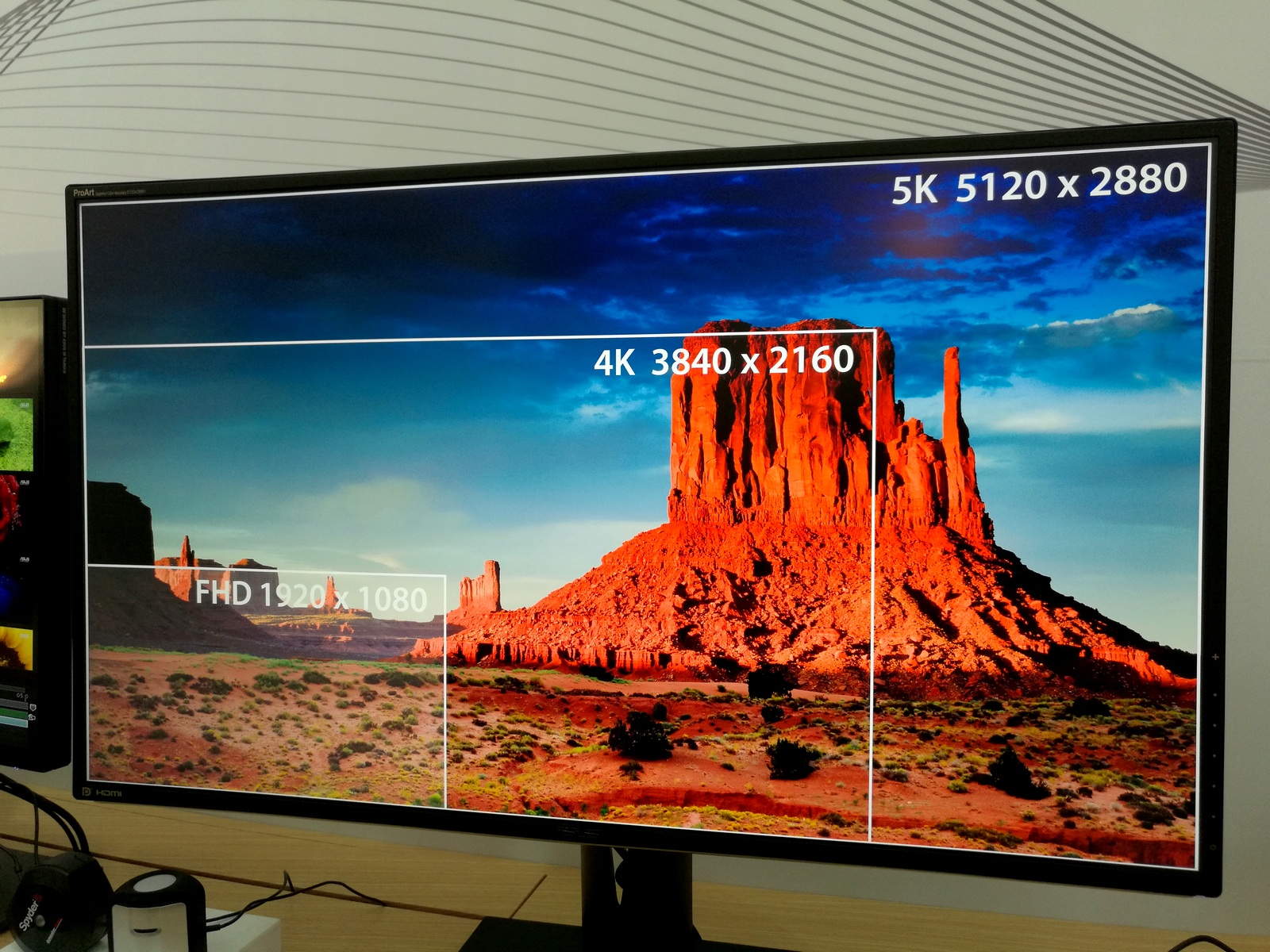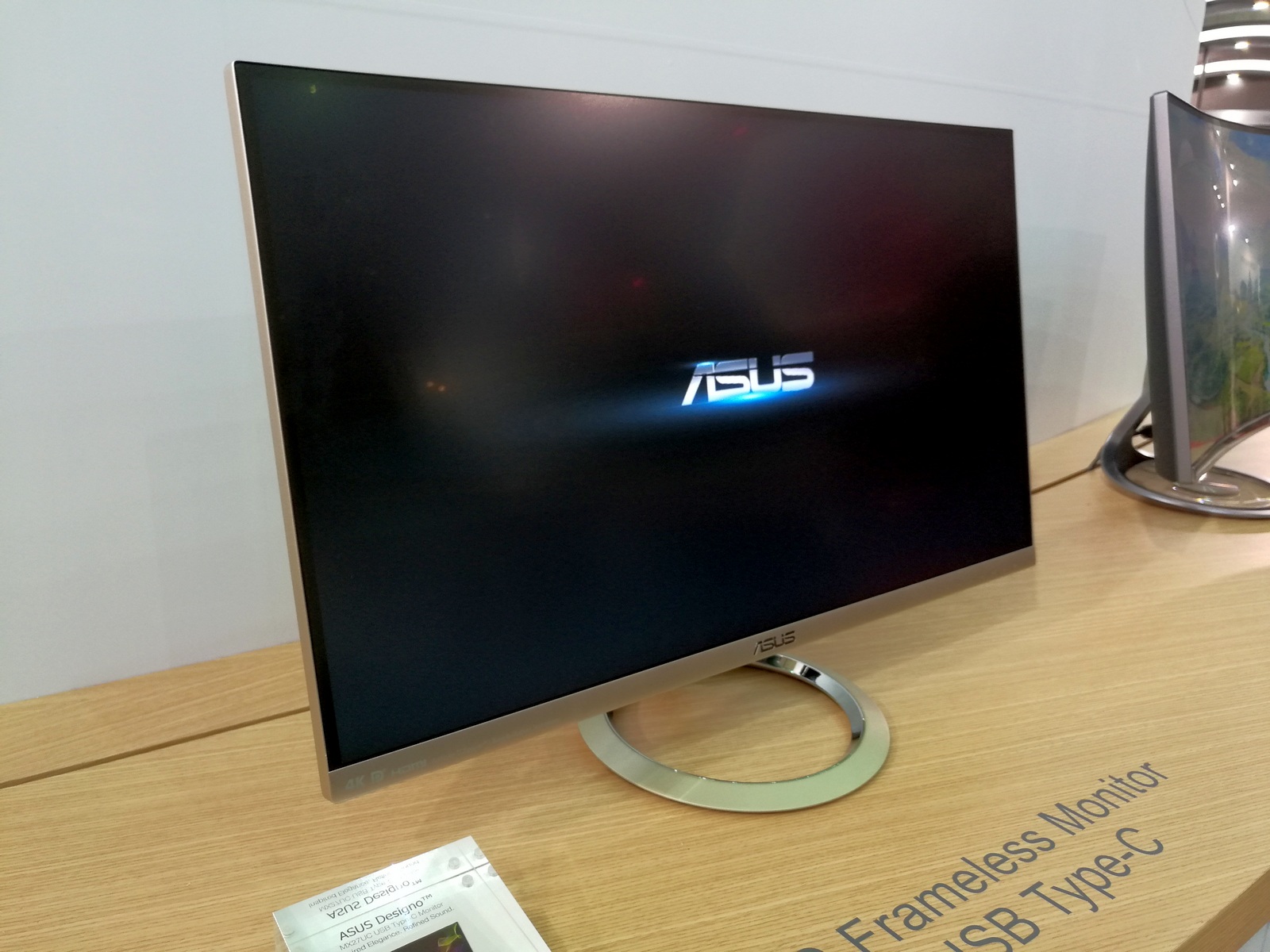ASUS at Computex 2016: The 10 Years of the Republic Of Gamers (ROG) Booth Tour
by Ian Cutress on June 22, 2016 8:00 AM ESTAnyone remember when 32-inch 4K monitors were $3500? We reviewed ASUS’ PQ321Q back in July 2013, and since then every monitor manufacturer under the sun has some 4K variant, or in some cases, a wide variety of high-performance, high-quality panels broaching professional status and all at a seemingly cheaper price than what we saw only three years ago. Case in point, my three Dell UP2415Q monitors I purchased in 2015 were under $500 each (it was either that or buy a DSLR; the monitors won). But now that 4K is slowly moving down the chain into the mainstream, even with ultra-wide 21:9 monitors in tow for gaming, the next barrier is 5K.
5K monitors, using a 5120x2880 resolution, comes in at twice the 2560x1440 (colloquially ‘25x16’) panels we saw flood the market around the same time that 4K was starting to take hold. Of course, pushing 3.7 million pixels on a 25x16 panel back then was tough, but now going for almost 15 million pixels on the new 5K standard is somewhat insane. Luckily 14nm/16nm GPUs are being released this year…!
Apple’s 5K iMac has been the first serious attempt at a 5K display, attaching a custom TCON arrangement to a 27-inch panel. The minimum price for this is $1800, but that includes the rest of the iMac: a quad-core Intel Core i5 processor with Iris Pro graphics, 8GB of memory, a 1TB mechanical drive, and an AMD R9 M380 high-end mobile graphics card. Dell’s 5K panel, the UP2715K, can be used on any monitor with dual DisplayPort in MST mode. Luckily MST modes are more mature than when they first appeared on 4K, and from what is online, the 5K MST mode is more manageable than it was back in 2013.
The ASUS ProArt
So enter ASUS into the 5K market, with the ASUS 32-inch 5K ProArt display.
The ProArt name and lack of an official SKU number suggests both that ASUS is aiming for the professional market first and that the device is still being finalized.
With the display, ASUS is quoting 100% Rec.709, 99.5% AdobeRGB and 95% DCI-P3 in terms of color reproduction, as well as bundling the display with ASUS’ ProArt calibration tools. The display will support DisplayPort 1.3, which suggests that only a single cable should be needed to run at 60Hz when using 24-bit color. Given that this is a professional display, I would assume that increasing the color bit-depth to 10-bit would require a reduction in refresh rate to compensate.
Connectivity on the rear includes HDMI 2.0, DisplayPort 1.3, five USB 3.0 ports (a hub) and a 9-in-1 card reader.
DisplayPort over Type-C: The ASUS 4K Designo MX27UC
The march towards Type-C acceptance is strong, and one of the poignant benefits of Type-C is meant to be that in the right circumstances, it will support video. We’ve seen Apple’s Thunderbolt display do something similar in the past using Thunderbolt, but in this case the new ASUS Designo MX27UC uses the USB 3.1 Type-C port with power delivery, DisplayPort alternate mode and data transmission modes.
Rather than a professional display, ASUS is butting this into a premium look product. The MX27UC will have a 3840x2160 (‘4K’/UHD) resolution, a brushed metal ‘frameless’ design and Bang&Olufsen speaker technology. It is worth noting that while frameless, it isn’t actually borderless, with a good 5-7mm around the display being required around the edges.














43 Comments
View All Comments
alphasquadron - Wednesday, June 22, 2016 - link
I used to think that too. I would think that the market for young kids who can afford such huge expensive machines would be quite small as it would it would compose of rich people and not middle class which is much larger market. But as companies make more crazy led shiny cases and even have ram modules that have lights and crap on them, I want to say that either they are just dumb and don't know how to sell stuff or that they have much more real live market data then I do and that these things actually are a good thing to make. I could never see it but maybe these things do provide a good revenue source for the company.Gastec - Wednesday, August 31, 2016 - link
I'm not sure that's the fact in North America. Not since the 15-30 years of age group queued for miles and waited for days to buy $500-600 iPhones.hechacker1 - Wednesday, June 22, 2016 - link
I went with another ATX case because I wanted a silent build, which includes AIO radiators for when you are actually using a Broadwell-E at 100%, along with powerful GPU. They can dump out a lot of heat.Right now my 6800k is using 45w at idle with a 4.3GHz overclock. That's according to the motherboard sensor on the Strix x99 Gaming that was mentioned in this article.
So while 45w isn't that much and can easily be handled by a HSF, at full tilt it's rated for 140w TDP (probably less because the 6800k is cut down).
Anyways, that's to say since I do VR with it, SLI really isn't a factor today and I use a single GPU. What ATX does allow is future further expansion via add in cards, and great and silent cooling. My whole rig has fans that are less than <1000 rpm at all times, and so it's almost always silent.
Bragabondio - Wednesday, June 22, 2016 - link
Nice rig heckhacker! Nowadays the components are getting more power efficient so I am planning on downgrading from 650W power supply to 550W one. As for silent build I am pretty sure I could make my rig as silent as I need it in mATX case (I am ready to go with minimum overclock to keep the noise down). In the eternal dilemma between firepower and mobility I prefer mobility (within a reason).BrokenCrayons - Thursday, June 23, 2016 - link
I'm continuing to use an ATX case for cooling, but the motherboard inside it is mATX since I finished my most recent upgrade. I briefly considered grabbing a smaller case, but it seemed like a waste of $30 to pick one up when there's nothing wrong with the old Lian Li tower on wheels from 2008 aside from the fact that it's got more space than I need right now.milkod2001 - Thursday, June 23, 2016 - link
Because it might be much easier to design full atx LGA 2011-v3 motherboard with all features enabled than micro/mini atx variant. I don't see that as a big issue though. You don't have to get monster case for that. Just get the smallest decent case for full atx mobo and have it sitting under table. Or don't go for LGA 2011-v3 get something simpler if you don't need all features if offers.fanofanand - Wednesday, June 22, 2016 - link
Nice work Ian, thanks for the info!madwolfa - Wednesday, June 22, 2016 - link
What's up with leather jackets?BrokenCrayons - Wednesday, June 22, 2016 - link
It's probably just attire the company's employees believe will appeal to people within their target market.iamkyle - Wednesday, June 22, 2016 - link
Of course, the x99 Edition 10 board doesn't come with 10GbE. But still commands the price premium.Looks like ASUS is all about money instead of delivering actual value.